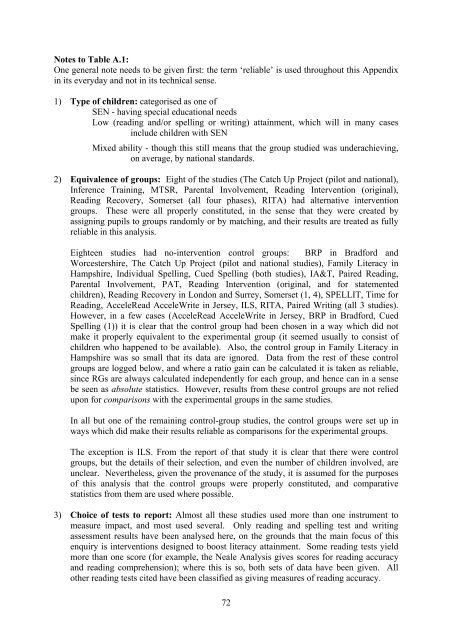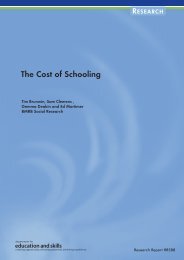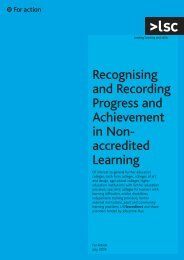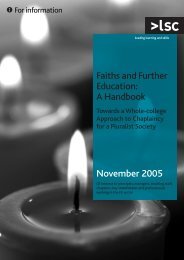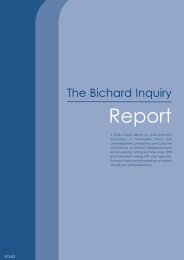What Works for Children with Literacy Difficulties? - Digital ...
What Works for Children with Literacy Difficulties? - Digital ...
What Works for Children with Literacy Difficulties? - Digital ...
Create successful ePaper yourself
Turn your PDF publications into a flip-book with our unique Google optimized e-Paper software.
Notes to Table A.1:<br />
One general note needs to be given first: the term ‘reliable’ is used throughout this Appendix<br />
in its everyday and not in its technical sense.<br />
1) Type of children: categorised as one of<br />
SEN - having special educational needs<br />
Low (reading and/or spelling or writing) attainment, which will in many cases<br />
include children <strong>with</strong> SEN<br />
Mixed ability - though this still means that the group studied was underachieving,<br />
on average, by national standards.<br />
2) Equivalence of groups: Eight of the studies (The Catch Up Project (pilot and national),<br />
Inference Training, MTSR, Parental Involvement, Reading Intervention (original),<br />
Reading Recovery, Somerset (all four phases), RITA) had alternative intervention<br />
groups. These were all properly constituted, in the sense that they were created by<br />
assigning pupils to groups randomly or by matching, and their results are treated as fully<br />
reliable in this analysis.<br />
Eighteen studies had no-intervention control groups: BRP in Brad<strong>for</strong>d and<br />
Worcestershire, The Catch Up Project (pilot and national studies), Family <strong>Literacy</strong> in<br />
Hampshire, Individual Spelling, Cued Spelling (both studies), IA&T, Paired Reading,<br />
Parental Involvement, PAT, Reading Intervention (original, and <strong>for</strong> statemented<br />
children), Reading Recovery in London and Surrey, Somerset (1, 4), SPELLIT, Time <strong>for</strong><br />
Reading, AcceleRead AcceleWrite in Jersey, ILS, RITA, Paired Writing (all 3 studies).<br />
However, in a few cases (AcceleRead AcceleWrite in Jersey, BRP in Brad<strong>for</strong>d, Cued<br />
Spelling (1)) it is clear that the control group had been chosen in a way which did not<br />
make it properly equivalent to the experimental group (it seemed usually to consist of<br />
children who happened to be available). Also, the control group in Family <strong>Literacy</strong> in<br />
Hampshire was so small that its data are ignored. Data from the rest of these control<br />
groups are logged below, and where a ratio gain can be calculated it is taken as reliable,<br />
since RGs are always calculated independently <strong>for</strong> each group, and hence can in a sense<br />
be seen as absolute statistics. However, results from these control groups are not relied<br />
upon <strong>for</strong> comparisons <strong>with</strong> the experimental groups in the same studies.<br />
In all but one of the remaining control-group studies, the control groups were set up in<br />
ways which did make their results reliable as comparisons <strong>for</strong> the experimental groups.<br />
The exception is ILS. From the report of that study it is clear that there were control<br />
groups, but the details of their selection, and even the number of children involved, are<br />
unclear. Nevertheless, given the provenance of the study, it is assumed <strong>for</strong> the purposes<br />
of this analysis that the control groups were properly constituted, and comparative<br />
statistics from them are used where possible.<br />
3) Choice of tests to report: Almost all these studies used more than one instrument to<br />
measure impact, and most used several. Only reading and spelling test and writing<br />
assessment results have been analysed here, on the grounds that the main focus of this<br />
enquiry is interventions designed to boost literacy attainment. Some reading tests yield<br />
more than one score (<strong>for</strong> example, the Neale Analysis gives scores <strong>for</strong> reading accuracy<br />
and reading comprehension); where this is so, both sets of data have been given. All<br />
other reading tests cited have been classified as giving measures of reading accuracy.<br />
72


